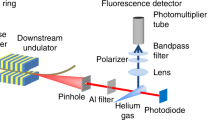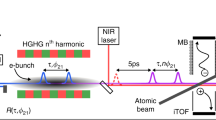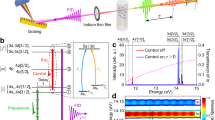Abstract
Ultrafast extreme ultraviolet (XUV) transient absorption is the process by which atoms and molecules absorb light on a timescale faster than the lifetime of the states involved. Coherent control uses quantum coherences to manipulate quantum pathways in light–matter interactions. Here we combine the two. We show that we can control the absorption spectral lineshape, changing it from Lorentzian to Fano to inverted Lorentzian and back again. The control is achieved by creating quantum coherence in the ground electronic state of hydrogen molecules, long before the arrival of the ultrafast XUV pulse. We show that the absorption can become negative at 12 eV, which is the optical gain. These observations provide new insights into the control of spectral lineshapes and open the way for achieving lasing without inversion in the XUV spectral range.
This is a preview of subscription content, access via your institution
Access options
Access Nature and 54 other Nature Portfolio journals
Get Nature+, our best-value online-access subscription
$29.99 / 30 days
cancel any time
Subscribe to this journal
Receive 12 print issues and online access
$209.00 per year
only $17.42 per issue
Buy this article
- Purchase on Springer Link
- Instant access to full article PDF
Prices may be subject to local taxes which are calculated during checkout






Similar content being viewed by others
Data availability
The data that support the findings of this study are available from the corresponding authors upon reasonable request.
Code availability
The code used in this study is available from the corresponding authors upon reasonable request.
References
Safavi-Naeini, A. H. et al. Electromagnetically induced transparency and slow light with optomechanics. Nature 472, 69–73 (2011).
Fleischhauer, M., Imamoglu, A. & Marangos, J. P. Electromagnetically induced transparency: optics in coherent media. Rev. Mod. Phys. 77, 633–673 (2005).
Wang, C. Q. et al. Electromagnetically induced transparency at a chiral exceptional point. Nat. Phys. 16, 334–340 (2020).
Arimondo, E. Coherent population trapping in laser spectroscopy. Prog. Opt. 35, 257–354 (1996).
Donarini, A. et al. Coherent population trapping by dark state formation in a carbon nanotube quantum dot. Nat. Commun. 10, 381 (2019).
Scully, M. O. & Fleischhauer, M. Lasers without inversion. Science 263, 337–338 (1994).
Mompart, J. & Corbalán, R. Lasing without inversion. J. Opt. B: Quantum Semiclass. Opt. 2, R7–R24 (2000).
Richter, M. et al. Rotational quantum beat lasing without inversion. Optica 7, 586–592 (2020).
Langin, T. K., Gorman, G. M. & Killian, T. C. Laser cooling of ions in a neutral plasma. Science 363, 61–64 (2019).
Ludlow, A. D., Boyd, M. M., Ye, J., Peik, E. & Schmidt, P. O. Optical atomic clocks. Rev. Mod. Phys. 87, 637–701 (2015).
Villeneuve, D. M., Hockett, P., Vrakking, M. J. J. & Niikura, H. Coherent imaging of an attosecond electron wave packet. Science 356, 1150–1153 (2017).
Goulielmakis, E. et al. Real-time observation of valence electron motion. Nature 466, 739–743 (2010).
Hosler, E. R. & Leone, S. R. Characterization of vibrational wave packets by core-level high-harmonic transient absorption spectroscopy. Phys. Rev. A 88, 023420 (2013).
Wei, Z. R. et al. Elucidating the origins of multimode vibrational coherences of polyatomic molecules induced by intense laser fields. Nat. Commun. 8, 735 (2017).
Wu, M., Chen, S., Camp, S., Schafer, K. J. & Gaarde, M. B. Theory of strong-field attosecond transient absorption. J. Phys. B: At. Mol. Opt. Phys. 49, 062003 (2016).
Santra, R., Yakovlev, V. S., Pfeifer, T. & Loh, Z.-H. Theory of attosecond transient absorption spectroscopy of strong-field-generated ions. Phys. Rev. A 83, 033405 (2011).
Ott, C. et al. Lorentz meets Fano in spectral line shapes: a universal phase and its laser control. Science 340, 716–720 (2013).
Kaldun, A. et al. Observing the ultrafast buildup of a Fano resonance in the time domain. Science 354, 738–741 (2016).
Bengtsson, S. et al. Space-time control of free induction decay in the extreme ultraviolet. Nat. Photon. 11, 252–258 (2017).
Chini, M. et al. Subcycle a.c. Stark shift of helium excited states probed with isolated attosecond pulses. Phys. Rev. Lett. 109, 073601 (2012).
Chini, M. et al. Sub-cycle oscillations in virtual states brought to light. Sci. Rep. 3, 1105 (2013).
Liao, C.-T., Sandhu, A., Camp, S., Schafer, K. J. & Gaarde, M. B. Beyond the single-atom response in absorption line shapes: probing a dense, laser-dressed helium gas with attosecond pulse trains. Phys. Rev. Lett. 114, 143002 (2015).
Drescher, L. et al. Extreme-ultraviolet spectral compression by four-wave mixing. Nat. Photon. 15, 263–266 (2021).
Pertot, Y. et al. Time-resolved X-ray absorption spectroscopy with a water window high-harmonic source. Science 355, 266–267 (2017).
Kobayashi, Y., Chang, K. F., Zeng, T., Neumark, D. M. & Leone, S. R. Direct mapping of curve-crossing dynamics in IBr by attosecond transient absorption spectroscopy. Science 365, 79–83 (2019).
Loh, Z.-H. et al. Observation of the fastest chemical processes in the radiolysis of water. Science 367, 179–182 (2020).
Reduzzi, M. et al. Observation of autoionization dynamics and sub-cycle quantum beating in electronic molecular wave packets. J. Phys. B: At. Mol. Opt. Phys. 49, 065102 (2016).
Cheng, Y. et al. Reconstruction of an excited-state molecular wave packet with attosecond transient absorption spectroscopy. Phys. Rev. A 94, 023403 (2016).
Peng, P. et al. Symmetry of molecular Rydberg states revealed by XUV transient absorption spectroscopy. Nat. Commun. 10, 5269 (2019).
Schultze, M. et al. Attosecond band-gap dynamics in silicon. Science 346, 1348–1352 (2014).
Lucchini, M. et al. Attosecond dynamical Franz-Keldysh effect in polycrystalline diamond. Science 353, 916–919 (2016).
Moulet, A. et al. Soft X-ray excitonics. Science 357, 1134–1138 (2017).
Schlaepfer, F. et al. Attosecond optical-field-enhanced carrier injection into the GaAs conduction band. Nat. Phys. 14, 560–564 (2018).
Warrick, E. R. et al. Attosecond transient absorption spectroscopy of molecular nitrogen: vibrational coherences in the \(\mathrm{b}^{\prime 1}{{\Sigma }}_\mathrm{u}^ +\) state. Chem. Phys. Lett. 683, 408–415 (2017).
Drescher, L. et al. State-resolved probing of attosecond timescale molecular dipoles. J. Phys. Chem. Lett. 10, 265–269 (2019).
Kraus, P. M. et al. Measurement and laser control of attosecond charge migration in ionized iodoacetylene. Science 350, 790–795 (2015).
Lee, K. F., Villeneuve, D. M., Corkum, P. B., Stolow, A. & Underwood, J. G. Field-free three-dimensional alignment of polyatomic molecules. Phys. Rev. Lett. 97, 173001 (2006).
Stapelfeldt, H. & Seideman, T. Colloquium: aligning molecules with strong laser pulses. Rev. Mod. Phys. 75, 543–557 (2003).
Hammond, T. J. et al. Integrating solids and gases for attosecond pulse generation. Nat. Photon. 11, 594–599 (2017).
Mi, Y. H. et al. Clocking enhanced ionization of hydrogen molecules with rotational wave packets. Phys. Rev. Lett. 125, 173201 (2020).
Scully, M. O., Zhu, S.-Y. & Gavrielides, A. Degenerate quantum-beat laser: lasing without inversion and inversion without lasing. Phys. Rev. Lett. 62, 2813–2816 (1989).
Harris, S. E. Lasers without inversion: interference of lifetime-broadened resonances. Phys. Rev. Lett. 62, 1033–1036 (1989).
Fry, E. S. et al. Atomic coherence effects within the sodium D1 line: lasing without inversion via population trapping. Phys. Rev. Lett. 70, 3235–3238 (1993).
van der Veer, W. E., van Diest, R. J. J., Dönszelmann, A. & van Linden van den Heuvell, H. B. Experimental demonstration of light amplification without population inversion. Phys. Rev. Lett. 70, 3243–3246 (1993).
Nottelmann, A., Peters, C. & Lange, W. Inversionless amplification of picosecond pulses due to Zeeman coherence. Phys. Rev. Lett. 70, 1783–1786 (1993).
Ramakrishna, S. & Seideman, T. Dissipative dynamics of laser induced nonadiabatic molecular alignment. J. Chem. Phys. 124, 034101 (2006).
Yao, J. P. et al. High-brightness switchable multiwavelength remote laser in air. Phys. Rev. A 84, 051802 (2011).
Xu, H. L., Lӧtstedt, E., Iwasaki, A. & Yamanouchi, K. Sub-10-fs population inversion in N2+ in air lasing through multiple state coupling. Nat. Commun. 6, 8347 (2015).
Britton, M. et al. Testing the role of recollision in N2+ air lasing. Phys. Rev. Lett. 120, 133208 (2018).
Acknowledgements
We thank D. Crane and R. Kroeker for technical support. We acknowledge fruitful discussions with A. Korobenko, G. Xin, A. Stolow, M. Spanner, B. Bernhardt and V. Schuster. This research is supported by the NSERC Discovery Grant program (RGPIN-327147-2012; D.M.V.), and by the US Army Research Office through award W911NF-14-1-0383 (D.M.V.). We acknowledge support of the Joint Centre for Extreme Photonics (P.B.C. and D.M.V.), the DFG (grant no. MI 2434/1-1; Y.M.), and the start-up grant of ShanghaiTech University (P.P.).
Author information
Authors and Affiliations
Contributions
P.P. and D.M.V. conceived and planned the experiment. P.P., Y.M. and X.D. conducted the measurements. P.P. and D.M.V. analysed and interpreted the data. M.L. and M.B. provided the theoretical supporting calculations. A.Y.N., P.B.C. and D.M.V. supervised the project. P.P. wrote the manuscript, with inputs from all the authors.
Corresponding authors
Ethics declarations
Competing interests
The authors declare no competing interests.
Additional information
Peer review information Nature Photonics thanks the anonymous reviewers for their contribution to the peer review of this work.
Publisher’s note Springer Nature remains neutral with regard to jurisdictional claims in published maps and institutional affiliations.
Supplementary information
Supplementary Information
Supplementary Figs. 1–10 and Sections 1–5.
Rights and permissions
About this article
Cite this article
Peng, P., Mi, Y., Lytova, M. et al. Coherent control of ultrafast extreme ultraviolet transient absorption. Nat. Photon. 16, 45–51 (2022). https://doi.org/10.1038/s41566-021-00907-7
Received:
Accepted:
Published:
Issue Date:
DOI: https://doi.org/10.1038/s41566-021-00907-7
This article is cited by
-
Rebuilding the vibrational wavepacket in TRAS using attosecond X-ray pulses
Communications Physics (2024)
-
Interference of the Electric and Envelope Areas of Ultrashort Light Pulses in Quantum Systems
Radiophysics and Quantum Electronics (2024)
-
Photon-statistics force in ultrafast electron dynamics
Nature Photonics (2023)
-
Interference of the Electric and Envelope Areas of Ultrashort Light Pulses in Quantum Systems
Radiophysics and Quantum Electronics (2023)
-
Attosecond coherent control of electronic wave packets in two-colour photoionization using a novel timing tool for seeded free-electron laser
Nature Photonics (2023)



